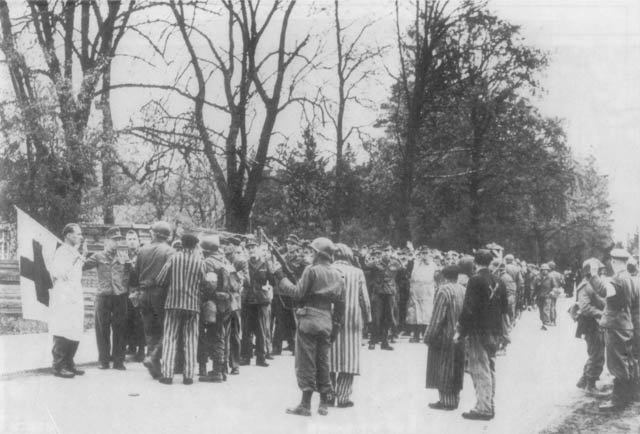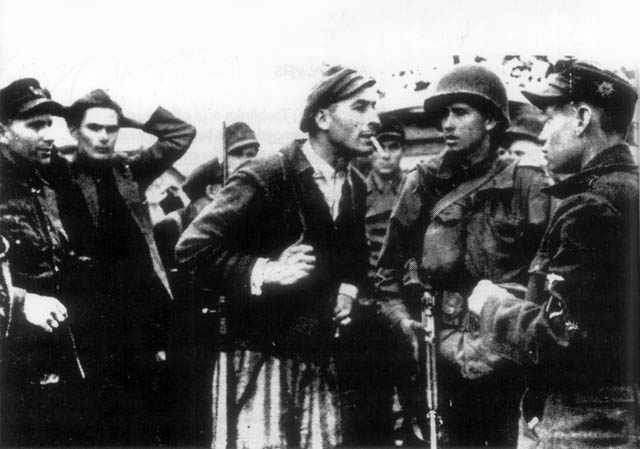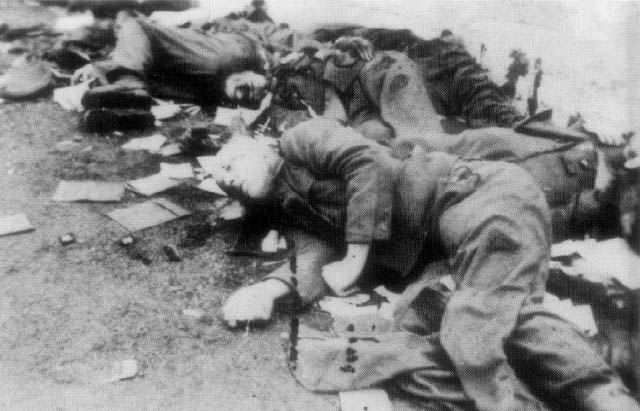

|
06:00 Waffen SS-Obersturmführer (Lt.) Heinrich Skodzensky, the new, hastily designated Camp Commandant, holds morning roll call for the garrison now guarding Dachau. His roll call tallied 560 men, many of them in hospital. A mere lieutenant had never before commanded the massive concentration camp, but the real SS Commandant, Martin Gottfried Weiss, had "run off" the day before, along with more than a thousand of the Allgemeine and Death's Head SS guards stationed at the camp prior to the American approach. Skodzensky's orders were to surrender. (Dachau Archive) 07:35 3rd Battalion, 157th Infantry Regiment, of the U.S. 45th (Thunderbird) Division, as part of Task Force Love, jumps off from the village of Gross Inzemoos (10 miles northeast of Augsburg) with three rifle companies supported by tanks. 08:30 After eliminating sniper pockets, 3rd Battalion is temporarily halted by a blown bridge near Ampermocking, some four miles from the city of Dachau. 09:30 Tanks of the 101st Tank Battalion enter the city of Dachau after an alternate river crossing is found. 10:00 Two rifle companies (K and L) of 3rd Battalion are dispatched to attack toward Munich. I Company is held in reserve. 10:15 3rd Battalion HQ receives orders to capture the camp at Dachau. 10:30 I Company and elements of M Company (3rd Battalion) are dispatched in the direction of the concentration camp. Tanks are held up by a bridge over the Amper River which is blown when armor is within 20 yards, killing a large number of German soldiers who are unable to cross in time. 10:45 1st Lt. L.R. Stewart and 1st Sgt. Robert Wilson of L Company find a footbridge defended by a lone German machine gunner. After firing one belt of ammunition the German retreats and I Company then crosses. Tanks and L Company remain behind to clear Dachau and continue the attack toward Munich.  10:55 An Intelligence & Reconnaissance (I & R) patrol reaches the outskirts of the concentration camp and receives enemy fire. A jeep with four men sent from HQ to accept the German surrender turns around and flees the scene. Obersturmführer Skodzensky attempts to surrender the camp to the Americans, but is somehow shot and killed in the confusion.  11:00 Forward elements of I Company enter the concentration camp after finding and inspecting a trainload of dead prisoners. Pfc. John Degro of Burton, Ohio is believed to be the first American liberator to enter the concentration camp and come within view of the inmates. (Avenger)  11:20 American soldiers reach the inner compound where inmates are imprisoned. See location (A). 11:25 The crematorium and gas chamber are soon discovered at location (B). Pandemonium reigns and dead bodies are everywhere.  The original camp crematorium, built in 1940 as the death rate
in the camp began to increase, was replaced by the structure above in
1942. It has a larger physical plant, a gas chamber and four sophisticated
incinerators of the so-called "Baracke X" type. According to most
historians, the gas chamber, which was disguised as a shower room, was
never put into use. Several former inmates have said otherwise. (Courtesy
of Dachau Archive)
 11:30 The American GIs in a frenzy or horror, anger and guilt gun down some 122 captured German soldiers - most of them Waffen SS. Dozens of inmates break out of the prison enclosure and kill approximately 40 guards, some with their bare hands. Private John Lee of I Company later told newspapers that he was personally involved in at least 60 of the killings.  12:00 All resistance is silenced and escaped inmates are rounded up. Order is temporarily restored. 358 German soldiers are taken prisoner, many of them wounded Waffen SS men forced from their beds in the military hospital. 12:05 A GI machine gunner nicknamed "Birdeye" from M Company suddenly yells, "They're trying to get away," and opens up with his .30 caliber machine gun. Lt. Colonel Felix Sparks charges him from behind and kicks him away from the gun, saying "What in the Hell are you doing?"  Dead German soldiers at Dachau. Exact location unknown. They
are wearing Tarnjacke, camouflage uniforms, of Waffen-SS combat troops.
The head wound on the man in foreground appears to have been made by a US
.45 caliber pistol. It looks as if he saw the bullet coming and shielded
his eyes. According to Edwin F. Gorak, who took this photo on April 30,
1945, "the way the bodies were piled up seems to indicate they were slain
simultaneously, as by machine gun fire." (Courtesy of Edwin F. Gorak,
158th Field Artillery)
12:15 Order is restored once again. A moment of relative quiet ensues. 12:25 Brigadier General Henning Linden and party arrive. A lady newspaper reporter opens gate to inner compound and a number of inmates escape. 12:30 Most inmates are rounded up and returned to enclosure.  12:35 A verbal battle erupts between General Linden and Colonel Sparks. 12:45 General Linden and party depart. 12:50 Guards have been posted, tempers have cooled, emotions are being brought under control. The camp is finally secure. Col. Sparks reports to Regimental Headquarters and describes the events of the day.  A group of about 200 captured Germans soldiers being marched to
a holding enclosure in the same hospital area where the execution wall was
located. Lt. William Walsh is fourth from left with back to camera. Five
inmates can be seen assisting the Americans. The German medic with the Red
Cross flag is one of the few German staffers known to have survived the
liberation. (Courtesy of the 45th Division Museum)
13:30 Colonel Walter O'Brien and Captain Minor S. Shirk tour the camp.  14:30 Col. Sparks sets up a command post outside of the camp and awaits the arrival of his superior, General Frederick. Meanwhile, Lt. Walsh and elements of I Company withdraw to prepare for an attack on Munich. Chaplain Loy returns to city of Dachau.  A group of German guards being turned over to an American
soldier by an armed inmate carrying a German rifle. This same man can be
seen below armed only with a shovel. (Courtesy of 45th Division
Museum)
14:35 Lt. Howard Buechner and Lt. Robert Kimsey arrive outside the camp. Both are medical officers and are the first doctors to arrive at the scene. 14:45 346 German soldiers are machine gunned by 1st Lt. Jack Bushyhead, the Executive Officer of I Company, at location (C). Lt. Bushyhead was a full-blooded Native American (Cherokee) from Oklahoma.  The photo above shows about 60 dead or wounded German guards
lying at the base of a long wall. Only about one fourth of the total
length of the wall is visible. A machine gunner crouches over a model
1919A4 machine gun, center foreground. The four German soldiers still
standing and three or four of their fallen comrades at left who are still
alive were shot only seconds after this photo was taken. A hospital
building can be seen at right. (Photo by Arland B. Musser, US Signal
Corps. Courtesy National Archives, Washington D.C.)
14:47 Lt. Buechner hears the sound of machine gun fire and arrives at the scene of the massacre just minutes after the photo above is taken. 14:49 Medical Sgt. Ralph Rosa and his party of medics arrive at the site of massacre.  Drawing of the execution site by Lt. Buechner. Dead German
soldiers are represented by "Xs," black dots are American soldiers,
machine guns are shown as circles, shown with approximate lines of fire. A
BAR man stands behind and to the right of the machine gun on left. "A"
shows the path of Lt. Buechner. The other is Sgt. Rosa's path. "25"
indicates the location of the two inmates beating the German guard with a
shovel below. (Buechner)
 Two inmates preparing to kill a fallen SS guard with a shovel.
In background rows of machine gunned German guards can be seen lying in
piles along the base of the hospital wall. A large hospital building can
be seen above right. The man on the left is same individual as above.
(Photographer unknown, probably T/4 Arland B. Musser, US Signal Corps.
Reproduced from "Day of the Americans" by Nerin Gun.)

 14:53 Lt. Kimsey peers over the wall (see diagram above) and sees that the elimination of the camp garrison has been completed. All captured Germans soldiers are either dead or dying. None of the U.S. medical personel, including Dr. Buechner, attempts to treat the wounded. Each man is shot individually. 15:00 Lt. Buechner and party inspect the camp until 1700. 15:15 Col. Sparks and Gen. Frederick tour the camp until 1700.  SS rifle range at Hebertshausen near Dachau where thousands of
Soviet prisoners of war were executed in 1941 and 1942. Many unknown
prisoners were also secretly executed here between 1933 and 1945. Their
exact number will never be known. (Dachau Archive)
18:00 Elements of the lst Battalion (C Company) and one platoon of L Company (157th Inf.) arrive to assist with guard duty.  From 1933 to 1945, 206,206 prisoners had been registered at Dachau. The total number of dead will never be known. Soviet prisoners of war were summarily executed by the thousands, civilians were assigned by the Gestapo to the camp for Sonderbehandlung ("Special Treatment," a Nazi euphemism which signified "killing"), and a great many died in evacuation marches and death marches. These deaths were never registered. The International Tracing Service in Arolson reports 31,591 dead among the prisoners that were registered. The total number of Jews who died at Dachau from 1933 to 1945 was relatively low, probably no more than 5,000. On the day of liberation, some 2,500 of the 32,000 remaining inmates were Jewish. (Avenger) *Individual participants in the liberation have given various, conflicting reports concerning the actual time of the first American arrival at Dachau. The exact time can never be precisely established even with the help of official battle reports, most of which are confusing, contradictory and often based on guesses, estimates and approximations. There is, however, almost general agreement that the camp was "cleared" by 2:30 P.M. The timeline above is believe to be accurate within no more than a variance of one hour and is based largely on the war diary of Lt. Howard A. Buechner, his book "Hour of the Avenger" and battle reports of April 29, 1945. In September 1986, more than 40 years after the massacre at Dachau, retired U.S. Army Colonel Howard Buechner published the first hardcover edition of his long-suppressed book, "The Hour of the Avenger," detailing the grisly events of April 29, 1945. It was not until 1991 that the U.S. Army quietly declassified its secret report on the killings at Dachau. It details several other incidents that day: a U.S. lieutenant ordered four German soldiers into an empty boxcar and personally shot each of them. Another American soldier clubbed and shot those still moaning. Several GIs turned their backs on two inmates beating a German guard to death with a shovel. It was said that one of the inmates had been castrated by the German they were murdering. See photo above. |
|
|
|
|
|
|
|
|
|